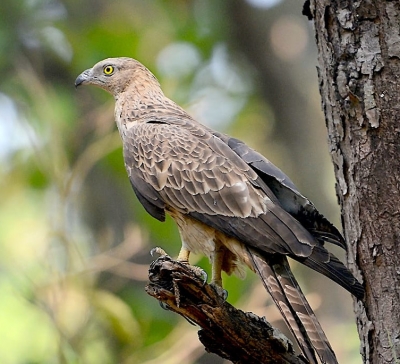
The Oriental honey-buzzard, or Pernis ptilorhynchus, is a medium-sized raptor that belongs to the family Accipitridae. It inhabits woodlands of many climatic types preferring lowland, broadleaf and mixed forests. It is found in the Indian subcontinent, Southeast Asia, the Philippines and Indonesia.
This raptor has a longish neck, a small head and a long tail. It is brown above and paler below, with males having a blue-gray head and females having a brown head. Unlike other birds of prey, this bird has a very unraptor-like face. Its eyes are not as striking as an eagle’s as it does not have the frowning appearance of a predator. It lacks the superciliary ridge above the eye which gives typical raptors their fierce expression, making this bird’s face look more like a pigeon’s!
This bird is a specialist feeder that lives mainly on the larvae, pupae and adults of various species of wasps and bees. It also feeds on other insects, reptiles and amphibians, small mammals, bird nestlings and bird eggs, as well as some fruits and berries. They are also known to eat bits of honeycomb and honey, hence the name – honey buzzard. Its call is a clear ‘peee-luu’.
The female is generally larger and darker than the male. This species builds its nest from twigs, leaves and bits of cotton in the forks of trees. The female lays around 2 eggs and incubation is carried out by both parents. The incubation period is around 42 to 45 days.
This bird has a very large range of habitat and although its population is declining, it is not considered vulnerable. Main threats are other predators, degradation of habitats and loss of tree cover. It is listed under ‘Least Concern’ in the IUCN Red List.
Picture Credit : Google




